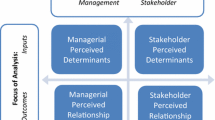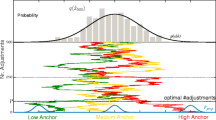Abstract
Intransitive preferences have been a topic of curiosity, study, and debate over the past 40 years. Many economists and decision theorists insist on transitivity as the cornerstone of rational choice, and even in behavioral decision theory intransitivities are often attributed to faulty experiments, random or sloppy choices, poor judgment, or unexamined biases. But others see intransitive preferences as potential truths of reasoned comparisons and propose representations of preferences that accommodate intransitivities.
This article offers a partial survey of models for intransitive preferences in a variety of decisional contexts. These include economic consumer theory, multiattribute utility theory, game theory, preference between time streams, and decision making under risk and uncertainty. The survey is preceded by a discussion of issues that bear on the relevance and reasonableness of intransitivity.
Similar content being viewed by others
References
Allais, Maurice. (1953a). “Fondements d'une théorie positive des choix comportant un risque et critique des postulats et axiomes de l'école americaine”. Memoir III,Econométrie, CNRS, Vol. XL, Paris, 257–332.
Allais, Maurice. (1953b). “Le comportement de l'homme rationnel devant le risque: critique des postulats ex axiomes de l'école americaine”,Econometrica 21, 503–546.
Allais, Maurice. (1979). “The So-called Allais Paradox and Rational Decisions under Uncertainty”, In M.Allais and O.Hagen (eds.),Expected Utility Hypotheses and the Allais Paradox. Dordrecht, Holland: Reidel, pp. 437–681.
Arrow, Kenneth J. (1951).Social Choice and Individual Values. New York: Wiley. Second edition, 1963.
Aumann, Robert J. (1962). “Utility Theory without the Completeness Axiom”,Econometrica 30, 445–462.
Aumann, Robert J. (1964). “Utility Theory without the Completeness Axiom: A Correction”,Econometrica 32, 210–212.
Bell, David. (1982). “Regret in Decision Making under Uncertainty”,Operations Research 30, 961–981.
Block, H. D. and Jacob, Marschak. (1960). “Random Orderings and Stochastic Theories of Responses”, In I.Olkin et al. (eds.),Contributions to Probability and Statistics. Stanford, CA: Stanford University Press, pp. 97–132.
Bostic, Raphael, R. J.Herrnstein, and R.Duncan Luce. (1988). “The Effect on the Preference-Reversal Phenomenon of Using Choice Indifferences”,Journal of Economic Behavior and Organization 13, 193–212.
Bouyssou, Denis. (1986). “Some Remarks on the Notion of Compensation in MCDM”,European Journal of Operational Research 26, 150–160.
Brown, Rex V. (1989). “Toward a Prescriptive Science and Technology of Decision Aiding”,Annals of Operations Research 19, 467–483.
Casey, Jeff T. (1990). “Reversal of the Preference Reversal Phenomenon”.Organizational Behavior and Human Decision Making
Chew SooHong. (1982). “A Mixture Set Axiomization of Weighted Utility Theory”, Discussion Paper 82–4, College of Business and Public Administration, University of Arizona, Tucson.
Chew SooHong. (1983). “A Generalization of the Quasilinear Mean with Applications to the Measurement of Income Inequality and Decision Theory Resolving the Allais Paradox”,Econometrica 51, 1065–1092.
Chew SooHong. (1985). “From Strong Substitution to Very Weak Substitution: Mixture-monotone Utility Theory and Semi-weighted Utility Theory”, preprint, Department of Political Economy, Johns Hopkins University, Baltimore.
Chew SooHong and Kenneth R.MacCrimmon. (1979). “Alpha-nu Choice Theory: A Generalization of Expected Utility Theory”, Working Paper 669, Faculty of Commerce and Business Administration, University of British Columbia, Vancouver.
Churchman, C. West (1961).Prediction and Optimal Decision. Englewood Cliffs, NJ: Prentice-Hall.
Condorcet, Marquis de. (1785). Essai sur l'application de l'analyse á la probabilité des décisions rendues á la pluralité des voix. Paris.
Cowan, Thomas and Peter C.Fishburn. (1988). “Foundations of Preference”, In G.Eberlein and H.Berghel (eds.),Essays in Honor of Werner Leinfellner. Theory and Decision Series. Dordrecht, Holland: Reidel, pp. 261–271.
Croon, M. A. (1984). “The Axiomization of Additive Difference Models for Preference Judgments”, In E.Degreef and G.VanBuggenhaut (eds.),Trends in Mathematical Psychology. Amsterdam: North-Holland, pp. 193–27.
Debreu, Gerard. (1960). “Topological Methods in Cardinal Utility Theory”, In K. J.Arrow, S.Karlin, and P.Suppes (eds.),Mathematical Methods in the Social Sciences, 1959. Stanford, CA: Stanford University Press, pp. 16–26.
Dekel, Eddie. (1986). “An Axiomatic Characterization of Preferences under Uncertainty: Weakening the Independence Axiom”,Journal of Economic Theory 40, 304–318.
Diamond, Peter A. (1967). “Cardinal Welfare, Individualistic Ethics, and Interpersonal Comparison of Utility: Comment”,Journal of Political Economy 75, 765–766.
Fishburn, Peter C. (1970a).Utility Theory for Decision Making. New York: Wiley.
Fishburn, Peter C. (1970b). “Intransitive Indifference in Preference Theory: A Survey”,Operations Research 18, 207–228.
Fishburn, Peter C. (1973a). “Binary Choice Probabilities: On the Varieties of Stochastic Transitivity”,Journal of Mathematical Psychology 10, 327–352.
Fishburn, Peter C. (1973b).The Theory of Social Choice. Princeton, NJ: Princeton University Press.
Fishburn, Peter C. (1974). “Lexicographic Orders, Utilities and Decision Rules: A Survey”,Management Science 20, 1442–1471.
Fishburn, Peter C. (1980). “Lexicographic Additive Differences”,Journal of Mathematical Psychology 21, 191–218.
Fishburn, Peter C. (1982). “Nontransitive Measurable Utility”,Journal of Mathematical Psychology 26, 31–67.
Fishburn, Peter C. (1983). “Transitive Measurable Utility”,Journal of Economic Theory 31, 293–317.
Fishburn, Peter C. (1984a). “Probabilistic Social Choice Based on Simple Voting Comparisons”,Review of Economic Studies 51, 683–692.
Fishburn, Peter C. (1984b). “Dominance in SSB Utility Theory”,Journal of Economic Theory 34, 130–148.
Fishburn, Peter C. (1984c). “Multiattribute Nonlinear Utility Theory”,Management Science 30, 1301–1310.
Fishburn, Peter C. (1985).Interval Orders and Interval Graphs. New York: Wiley.
Fishburn, Peter C. (1987). “Reconsiderations in the Foundations of Decision under Uncertainty”,Economic Journal 97, 825–841.
Fishburn, Peter C. (1988).Nonlinear Preference and Utility Theory. Baltimore: Johns Hopkins University Press.
Fishburn, Peter C. (1989). “Continuous Nontransitive Additive Conjoint Measurement”, forthcoming inMathematical Social Sciences.
Fishburn, Peter C. (1990a). “Nontransitive Additive Conjoint Measurement”,Journal of Mathematical Psychology.
Fishburn, Peter C. (1990b). “Skew Symmetric Additive Utility with Finite States”,Mathematical Social Sciences 19, 103–115.
Fishburn, Peter C. (1990c). “Additive Differences and Simple Preference Comparisons”,Journal of Mathematical Psychology.
Fishburn, Peter C. and Irving H.LaValle. (1987). “A Nonlinear, Nontransitive and Additive-probability Model for Decisions under Uncertainty”,Annals of Statistics 15, 830–844.
Fishburn, Peter C. and Irving H.LaValle. (1988). “Context-dependent Choice with Nonlinear and Nontransitive Preferences”,Econometrica 56, 1221–1239.
Fishburn, Peter C. and Bernard Monjardet. (1991). “Norbert Wiener on the Theory of Measurement (1914, 1915, 1921)”,Journal of Mathematical Psychology.
Fishburn, Peter C. and Yutaka Nakamura. (1991). “Nontransitive Measurable Utility with Constant Threshold”,Journal of Mathematical Psychology.
Fishburn, Peter C. and Philip D.Straffin. (1989). “Equity Considerations in Public Risks Evaluation”,Operations Research 37, 229–239.
Flood, Merrill M. (1951–1952). “A Preference Experiment”, The Rand Corporation Papers P-256, P-258, and P-263, Santa Monica, CA.
Goldstein, William and Hillel J.Einhorn (1987). “Expression Theory and the Preference Reversal Phenomenon”,Psychological Review 94, 236–254.
Hammond, Peter J. (1988). “Consequentialist Foundations for Expected Utility”,Theory and Decision 25, 25–78.
Krantz, David H., R. DuncanLuce, Patrick, Suppes, and Amos, Tversky. (1971).Foundations of Measurement, Volume I. New York: Academic Press.
Kreweras, Germain. (1961). “Sur une possibilité de rationaliser les intransitivités”,La Décision, CNRS, Paris, 27–32.
Kreweras, Germain. (1965). “Aggregation of Preference Orderings”. In Saul Sternberg et al. (comp.),Mathematics and Social Sciences I. Paris: Mouton, pp. 73–79.
LaValle, Irving H. (1990). “Small Worlds and Sure Things: Consequentialism by the Back Door”. In W. Edwards (ed.),Utility: Theories, Measurements, and Applications.
Loomes, Graham and Robert, Sugden. (1982). “Regret Theory: An Alternative Theory of Rational Choice under Uncertainty”,Economic Journal 92, 805–824.
Loomes, Graham and Robert, Sugden. (1987). “Some Implications of a More General Form of Regret Theory”,Journal of Economic Theory 41, 270–287.
Luce, R. Duncan. (1956). “Semiorders and a Theory of Utility Discrimination”,Econometrica 24, 178–191.
Luce, R. Duncan. (1959).Individual Choice Behavior: A Theoretical Analysis. New York: Wiley.
Luce, R. Duncan. (1978). “Lexicographic Tradeoff Structures”,Theory and Decision 9, 187–193.
Luce, R. Duncan and Howard, Raiffa. (1957).Games and Decisions. New York: Wiley.
Luce, R. Duncan and Patrick, Suppes. (1965). “Preference, Utility, and Subjective Probability”, In R. D.Luce, R. R.Bush, and E.Galanter (eds.),Handbook of Mathematical Psychology, III. New York: Wiley, pp. 249–410.
MacCrimmon, Kenneth R. and Stig, Larsson. (1979). “Utility Theory: Axioms Versus ‘Paradoxes’”. In M.Allais and O.Hagen (eds.),Expected Utility Hypotheses and the Allais Paradox. Dordrecht, Holland: Reidel, pp. 333–409.
Machina, Mark J. (1982). “‘Expected Utility’ Analysis without the Independence Axiom”,Econometrica 50, 277–323.
Mas-Colell, Andreu. (1974). “An Equilibrium Existence Theorem without Complete or Transitive Preferences”,Journal of Mathematical Economics 1, 237–246.
May, Kenneth O. (1954). “Intransitivity, Utility, and the Aggregation of Preference Patterns”,Econometrica 22, 1–13.
Merrill, Samuel. (1988).Making Multicandidate Elections More Democratic. Princeton, NJ: Princeton University Press.
Morrison, H. W. (1962). “Intransitivity of Paired Comparison Choices”, Ph.D. dissertation, University of Michigan, Ann Arbor.
Nakamura, Yutaka. (1985). “Weighted Linear Utility”, preprint, Department of Precision Engineering, Osaka University, Osaka, Japan.
Nakamura, Yutaka. (1990). “Bilinear Utility and a Threshold Structure for Nontransitive Preferences”,Mathematical Social Sciences 19, 1–21.
Peleg, Bezalel. (1984).Game Theoretic Analysis of Voting in Committees. Cambridge, England: Cambridge University Press.
Raiffa, Howard. (1968).Decision Analysis: Introductory Lectures on Choice under Uncertainty. Reading, MA: Addison-Wesley.
Ramsey, Frank P. (1931). “Truth and Probability”. InThe Foundations of Mathematics and Other Logical Essays. London: Routledge and Kegan Paul, pp. 156–198. Reprinted in H. E. Kyburg and H. E. Smokler (eds.),Studies in Subjective Probability. New York: Wiley, 1964, pp. 61–92.
Rapoport, Anatol. (1989).Decision Theory and Decision Behaviour. Dordrecht, Holland: Kluwer Academic.
Savage, Leonard J. (1954).The Foundations of Statistics. New York: Wiley.
Schkade, David A. and Eric J.Johnson. (1989). “Cognitive Processes in Preference Reversals”,Organizational Behavior and Human Decision Processes 44, 203–231.
Schmeidler, David. (1989). “Subjective Probability and Expected Utility without Additivity”,Econometrica 57, 571–587.
Slovic, Paul, Dale, Griffin, and Amos, Tversky. (1990). “Compatibility Effects in Judgment and Choice”. In R. M.Hogarth (ed.),Insights in Decision Making: Theory and Applications. Chicago: University of Chicago Press, pp. 5–27.
SlovicPaul and SarahLichtenstein (1968). “The Relative Importance of Probabilities and Payoffs in Risktaking,”Journal of Experimental Psychology Monograph Supplement 78, part 2, 1–18.
Sonnenschein, Hugo F. (1971). “Demand Theory without Transitive Preferences, with Applications to the Theory of Competitive Equilibrium.” In J. S.Chipman, L.Hurwicz, M. K.Richter, and H. F.Sonnenschein (eds.),Preferences, Utility, and Demand. New York: Harcourt Brace Jovanovich, pp. 215–223.
SuppesPatrick, David H.Krantz, R. DucanLuce, and AmosTversky. (1989).Foundations of Measurement, Volume II. New York: Academic Press.
TverskyAmos. (1969). “Intransitivity of Preferences,”Psychological Review 76, 31–48.
TverskyAmos and DanielKahneman. (1986). “Rational Choice and the Framing of Decisions.” In R. M.Hogarth and M. W.Reder (eds.),Rational Choice. Chicago: University of Chicago Press, pp. 67–94.
TverskyAmos, PaulSlovic, and DanielKahneman. (1990). “The Causes of Preference Reversal,”American Economic Review 80, 204–217.
VindKarl. (1991). “Independent Preferences,”Journal of Mathematical Economics 20, 119–135.
von, NeumannJohn and OskarMorganstern. (1944).Theory of Games and Economic Behavior. Princeton, NJ: Princeton University Press. Third edition, 1953.
Wakker, Peter P. (1989).Additive Representations of Preferences. Dordrecht, Holland: Kluwer Academic.
WienerNorbert. (1914). “A Contribution to the Theory of Relative Position,”Proceedings of the Cambridge Philosophical Society 17, 441–449.
Author information
Authors and Affiliations
Additional information
I thank Irving LaValle and Duncan Luce for valuable comments on a previous version of this article.
Rights and permissions
About this article
Cite this article
Fishburn, P.C. Nontransitive preferences in decision theory. J Risk Uncertainty 4, 113–134 (1991). https://doi.org/10.1007/BF00056121
Issue Date:
DOI: https://doi.org/10.1007/BF00056121




